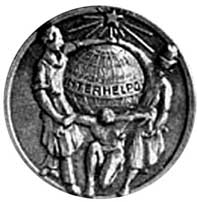More languages
More actions
No edit summary |
m (→History: Add placeholder headers.) |
||
| (5 intermediate revisions by 2 users not shown) | |||
| Line 1: | Line 1: | ||
{{stub}} | {{stub}} | ||
[[Image:Interhelpo Logo.jpg|thumb||Logo of Interhelpo]] | [[Image:Interhelpo Logo.jpg|thumb||Logo of Interhelpo]] | ||
'''International Worker Help''' ([[Ido]]: ''Internacia laboristal helpo''), abbreviated to '''interhelpo''', was a [[Czechoslovakia]]-based | '''International Worker Help''' ([[Ido]]: ''Internacia laboristal helpo''), abbreviated to '''interhelpo''', was a [[Czechoslovakia]]-based [[worker cooperative|cooperative]] for developing socialism in [[Bishkek]] (then Frunze) of [[Kirghiz Soviet Socialist Republic (1936–1991)|Soviet Kyrgyzstan]]. | ||
It became a successful cooperative in the [[Union of Soviet Socialist Republics (1922–1991)|Soviet Union]]. It has been slandered by [[bourgeois media]], accusing it of being a failure. | |||
==History== | ==History== | ||
==Further | ===Foundation=== | ||
Interhelpo was founded in 1923 by a group of Idists in response to the [[Communist International (1919–1943)|Communist International]]'s ''[[Library:Resolution on Proletarian Aid to Soviet Russia|Resolution on Proletarian Aid to Soviet Russia]]''. | |||
[[Rudolf Pavlovič Mareček]] recruited the first potential members from the circle of an Ido language club.<ref name=leupod>* {{Citation|title=“Building the Internationalist City from Below”: The Role of the Czechoslovak Industrial Cooperative “Interhelpo” in Forging Urbanity in early-Soviet Bishkek|author=David Leupold|doi=10.1017/S0147547920000228}}</ref> | |||
===Development=== | |||
===World War 2=== | |||
==Further reading== | |||
* {{Citation|title=“Building the Internationalist City from Below”: The Role of the Czechoslovak Industrial Cooperative “Interhelpo” in Forging Urbanity in early-Soviet Bishkek|author=David Leupold|doi=10.1017/S0147547920000228}} | * {{Citation|title=“Building the Internationalist City from Below”: The Role of the Czechoslovak Industrial Cooperative “Interhelpo” in Forging Urbanity in early-Soviet Bishkek|author=David Leupold|doi=10.1017/S0147547920000228}} | ||
== External | == External links == | ||
* {{Web citation|url=http://interhelpo.host.net.kg/|title=interhelpo_home.html|archive-url=https://web.archive.org/web/20070930180844/http://interhelpo.host.net.kg/}} | * {{Web citation|url=http://interhelpo.host.net.kg/|title=interhelpo_home.html|archive-url=https://web.archive.org/web/20070930180844/http://interhelpo.host.net.kg/}} | ||
Latest revision as of 09:25, 14 April 2023
 | This article is a stub. You can help improve this article by editing it. |

International Worker Help (Ido: Internacia laboristal helpo), abbreviated to interhelpo, was a Czechoslovakia-based cooperative for developing socialism in Bishkek (then Frunze) of Soviet Kyrgyzstan.
It became a successful cooperative in the Soviet Union. It has been slandered by bourgeois media, accusing it of being a failure.
History[edit | edit source]
Foundation[edit | edit source]
Interhelpo was founded in 1923 by a group of Idists in response to the Communist International's Resolution on Proletarian Aid to Soviet Russia.
Rudolf Pavlovič Mareček recruited the first potential members from the circle of an Ido language club.[1]
Development[edit | edit source]
World War 2[edit | edit source]
Further reading[edit | edit source]
- David Leupold. “Building the Internationalist City from Below”: The Role of the Czechoslovak Industrial Cooperative “Interhelpo” in Forging Urbanity in early-Soviet Bishkek. doi: 10.1017/S0147547920000228 [HUB]
External links[edit | edit source]
- "interhelpo_home.html". Archived from the original.
